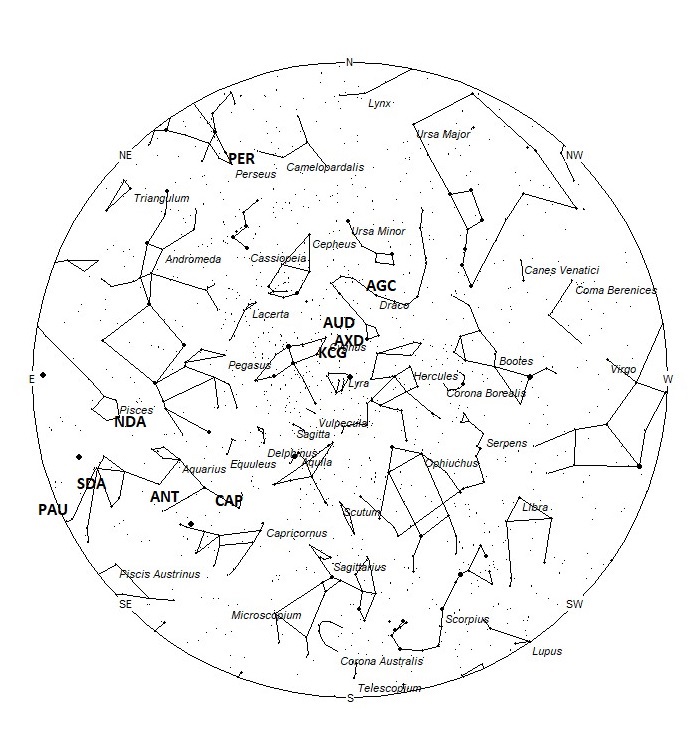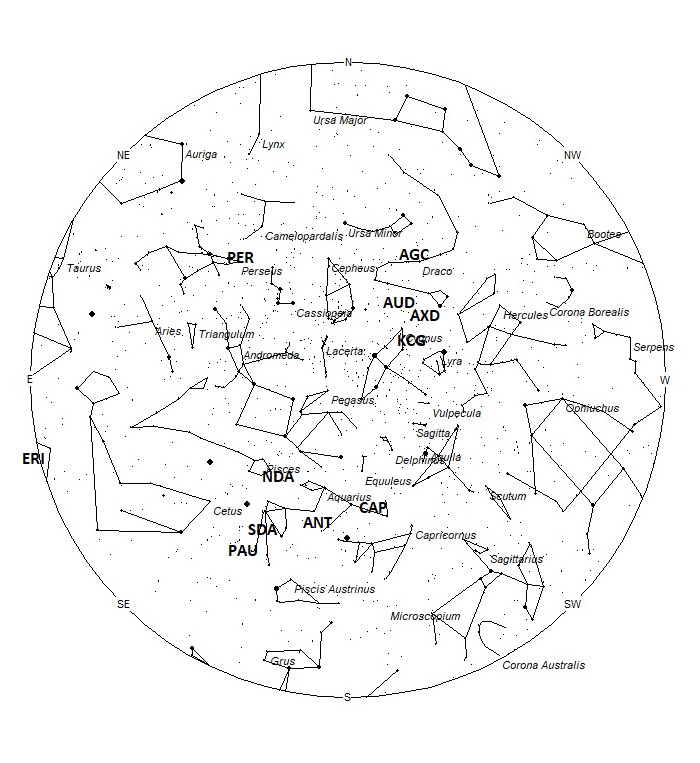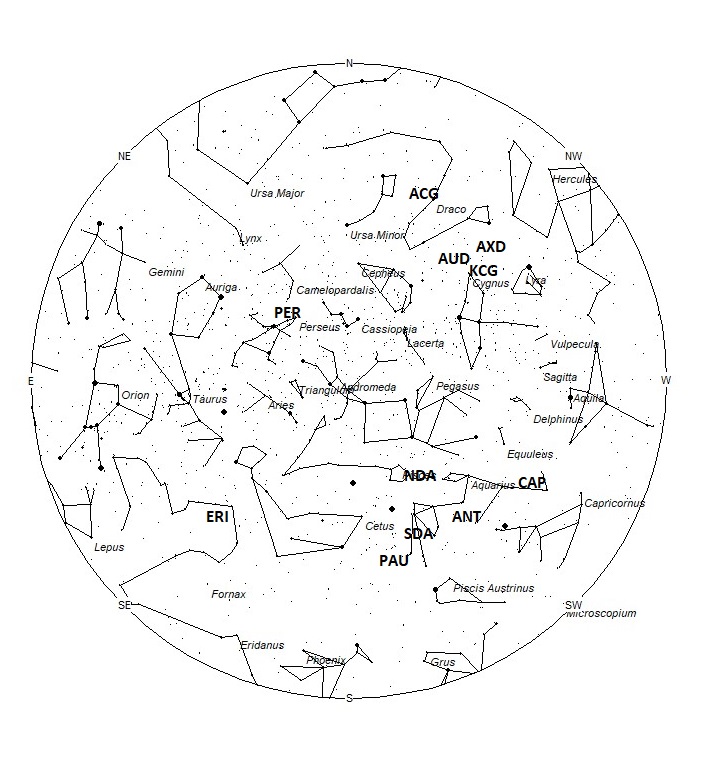 Daniel Bush captured this fireball low in the eastern sky at 04:33 UT on June 3rd 2022 (23:33 CDT on June 2, local date), from Albany, Missouri USA. For more information on this fireball visit: https://fireball.amsmeteors.org/members/imo_view/event/2022/3253 ©Daniel Bush
Daniel Bush captured this fireball low in the eastern sky at 04:33 UT on June 3rd 2022 (23:33 CDT on June 2, local date), from Albany, Missouri USA. For more information on this fireball visit: https://fireball.amsmeteors.org/members/imo_view/event/2022/3253 ©Daniel BushDuring this period, the moon reaches its last quarter phase on Friday August 19th. At that time the moon is located 90 degrees west of the sun and will rise near midnight local Daylight Saving Time (LDST). This weekend the waning gibbous moon will rise during the early evening hours, only allowing a brief time to view meteor under dark skies between dusk and moon rise. The estimated total hourly rates for evening observers this week should be near 2 as seen from mid-northern latitudes (45N) and 2 as seen from tropical southern locations (25S) For morning observers, the estimated total hourly rates should be near 23 as seen from mid-northern latitudes (45N) and 11 as seen from tropical southern locations (25S). The actual rates will also depend on factors such as personal light and motion perception, local weather conditions, alertness, and experience in watching meteor activity. Rates are reduced during this period due to moonlight. Note that the hourly rates listed below are estimates as viewed from dark sky sites away from urban light sources. Observers viewing from urban areas will see less activity as only the brighter meteors will be visible from such locations.
The radiant (the area of the sky where meteors appear to shoot from) positions and rates listed below are exact for Saturday night/Sunday morning August 13/14. These positions do not change greatly day to day so the listed coordinates may be used during this entire period. Most star atlases (available at science stores and planetariums) will provide maps with grid lines of the celestial coordinates so that you may find out exactly where these positions are located in the sky. I have also included charts of the sky that display the radiant positions for evening, midnight, and morning. The center of each chart is the sky directly overhead at the appropriate hour. These charts are oriented for facing south but can be used for any direction by rotating the charts to the desired direction. A planisphere or computer planetarium program is also useful in showing the sky at any time of night on any date of the year. Activity from each radiant is best seen when it is positioned highest in the sky, either due north or south along the meridian, depending on your latitude. It must be remembered that meteor activity is rarely seen at the radiant position. Rather they shoot outwards from the radiant, so it is best to center your field of view so that the radiant lies at the edge and not the center. Viewing there will allow you to easily trace the path of each meteor back to the radiant (if it is a shower member) or in another direction if it is sporadic. Meteor activity is not seen from radiants that are located far below the horizon. The positions below are listed in a west to east manner in order of right ascension (celestial longitude). The positions listed first are located further west therefore are accessible earlier in the night while those listed further down the list rise later in the night.
These sources of meteoric activity are expected to be active this week.
.
Details of each source will continue next week when lunar conditions are much more improved.
You can keep track of the activity of these meteor showers as well as those beyond the limits of visual observing by visiting the NASA Meteor Shower Portal available at: https://meteorshowers.seti.org/ You can move the sky globe to see different areas of the sky. Colored dots indicate shower meteors while white dots indicate sporadic (random) activity. The large orange disk indicates the position of the sun so little activity will be seen in that area of the sky.
The list below offers the information from above in tabular form. Rates and positions are exact for Saturday night/Sunday morning except where noted in the shower descriptions.
| SHOWER | DATE OF MAXIMUM ACTIVITY | CELESTIAL POSITION | ENTRY VELOCITY | CULMINATION | HOURLY RATE | CLASS |
| RA (RA in Deg.) DEC | Km/Sec | Local Daylight Saving Time |
North-South | |||
| August Gamma Cepheids (AGC) | Aug 29 | 16:59 (254) +71 | 41 | 21:00 | <1 – <1 | IV |
| August xi Draconids (AXD) | Aug 15 | 18:27 (277) +52 | 20 | 23:00 | <1 – <1 | IV |
| kappa Cygnids (KCG) | Aug 14 | 19:05 (286) +50 | 22 | 00:00 | <1 – <1 | II |
| zeta Draconids (AUD) | Aug 26 | 19:20 (291) +57 | 23 | 00:00 | <1 – <1 | IV |
| alpha Capricornids (CAP) | Jul 31 | 20:53 (313) -06 | 19 | 01:00 | 1 – <1 | II |
| Anthelion (ANT) | – | 22:16 (334) -11 | 30 | 02:00 | <1 – 2 | II |
| Northern delta Aquariids (NDA) | Aug 12 | 23:08 (347) +02 | 39 | 03:00 | <1 – <1 | IV |
| Southern delta Aquariids (SDA) | Jul 31 | 23:20 (350) -14 | 38 | 03:00 | <1 – 1 | I |
| Piscids Austrinids (PAU) | Aug 07 | 23:52 (358) -18 | 43 | 03:00 | <1 – <1 | IV |
| beta Hydusids (BHY) | Aug 17 | 02:25 (036) -75 | 23 | 05:00 | <1 – <1 | IV |
| eta Eridanids (ERI) | Aug 06 | 03:08 (047) -11 | 64 | 06:00 | <1 – <1 | II |
| Perseids (PER) | Aug 13 | 03:18 (050) +58 | 59 | 06:00 | 15 – 5 | I |
 American Meteor Society
American Meteor Society



Yesterday I was laying on my lounge chair I’m pretty sure I was watching shooting stars during the day they looked like silver streaks in the sky.
We had a meteor hit utah this morning
I saw 2 crazy bright ones tonight with my son letting the dogs out at 12 haha we thought we saw ufos it was crazy!!!!!
On August 17, 2022, at 9:00 pm Eastern, I was sitting outside in Bradenton, Florida, I was looking east, slightly north and witnessed a huge bright green ball, seemed to drop straight down and then burst into a gold color. I have never seen a sight like this, it was not like the shooting stars I have seen throughout my life.
We were on Moosehead lake in Maine lounging by the lake around 10:30 pm and saw a beautiful fireball whited, oranges, greens with a beautiful tail with like colors and almost a pink-gold color. The most amazing meteor we’ve spotted during Perseids!
Friday August 19th around 9:00 pm, we went down to the Rogue River near grants Pass Oregon, to dip our toes in the water after dinner. We looked North and saw a streak of light across the sky. We watched it travel with a long bright tail for 3-5 minutes. Magnificent!